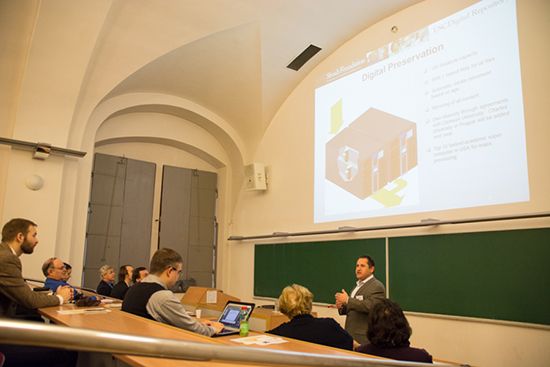Malach Center for Visual History in Prague Commemorates Six Years of Access to Visual History Archive
A diverse group of guests from NGOs, memory institutions and schools gathered in the heart of historical Prague at the Malach Center for Visual History at Charles University to commemorate its sixth anniversary as a full access site of the Visual History Archive.
The Malach Center for Visual History in Czech Republic is one of 53 word-wide access points to USC Shoah Foundation’s Visual History Archive. It was open at the Charles University in Prague in January 2010 as the third place in Europe to provide full access to the Visual History Archive to scholars, students and teachers.
On Monday, January 25, the center hosted its annual seminar which brings together partners and users who shared how the Visual History Archive has contributed to their work.
USC Shoah Foundation was represented by its chief technology officer Sam Gustman, who gave an engaging speech about the complicated process of archiving the large volumes of data constituting the Visual History Archive.

The second part of the program focused on teachers and researchers experience of employing the Visual History Archive in social sciences and humanities. Miroslav Michela, from the Faculty of Arts of the Charles University, spoke about his historiographical research on Jewish community in Slovakian-Hungarian city of Komárno-Komárom, and also about incorporating the survivor testimonies into his coursework. Hana Kubátová, from the Faculty of Social Sciences of the Charles University, explored the notion of “home return,” based on her work with testimony in preparation of an upcoming book on post-war Europe. Finally, Alfons Adam, historian from Terezín Initiative Institute, reflected on his experience with the Visual History Archive as a resource for preparing of an exhibition about forced labor camps, and he also mentioned some limitations of such archival research.
Apart from serving the scholars and researchers in diverse disciplines, the Malach Center also collaborates with local high school teachers and students. This aspect was reflected in the announcement of the winners of the fourth comic-strip competition. This year’s winner, Lukáš Vacek from Pilsen, impressed the jury especially with his mature artistic skills, original composition, and the unusual graphic technique of linocut.
The year 2016 will see the launch of several new projects and collaborations both at the Malach Center and the Institute of Formal and Applied Linguistics, which aim to develop new ways of utilizing oral history testimonies in research and education. Even after six years of access to the USC Shoah Foundation’s Visual History Archive in Prague, there are still many intriguing visions and possibilities.